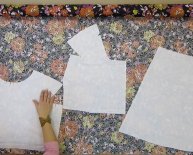
Drapery fabric characteristics
Drapery fabric can be any type of fabric that is used for window coverings or treatments. Almost any fabric can be used for draperies, but not all fabric is suitable for every application. Light, airy sheers come in easy-care synthetics, but they lack the privacy of heavier drapery fabric and need to be gathered to triple fullness to look attractive. Fabric-backed vinyl looks smart in a den or a masculine bedroom, but it lacks the refinement and elegance that befits a formal room.
Cotton is a popular drapery fabric and can be the least expensive choice. Available in a dizzying array of patterns and colors, cotton wears well and is available with flame-retardant, stain-repellant and shrink-resistant finishes. It comes in a variety of textures to suit every decorating style. Most cotton draperies are lined to give them a heavier, more substantial appearance, to make them hang better and to block out light more effectively. Cotton and polyester blends have many of the same characteristics as 100 percent cotton, and they can be used just as successfully for draperies.
Alone or blended with a synthetic such as polyester, linen is a versatile, moderately priced drapery fabric. When blended with a synthetic, it does not wrinkle or crease as pure linen does. Like cotton draperies, linen draperies are usually lined. Lining does the same things for linen that it does for cotton, but it also stabilizes the fabric, which can be somewhat stretchy in the looser weaves. An inner lining of blackout cloth may be necessary if the linen is very light weight and loosely woven.
Dupioni silk, a perennial favorite drapery fabric for formal settings, takes dye well and can be produced in brilliant jewel tones. Silk, with its lustrous sheen and hallmark slubs, is de rigueur for window treatments in the world’s finest homes and apartments. As lovely as it is, however, silk is not practical for children’s rooms or rooms visited often by pets. Sunlight will fade silk, especially deep or bright colors, so lining is required. Draperies in sunny windows may need an inner lining as well to avoid fading and dry rot.
Cotton, linen or linen blends and silk are the best choices for draw draperies or stationary panels on either side of a window, but sheer panels of cotton voile or polyester make attractive under drapes for an extra layer of beauty and texture at the window. While it does not afford nighttime privacy, sheer drapery fabric offers sufficient privacy during daylight hours to allow draperies to be left open. Sheer under drapes add a welcome touch of softness to any room and can be used to screen an unattractive view without sacrificing the light.

















